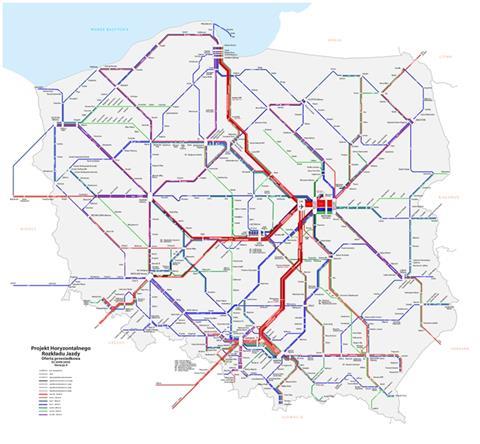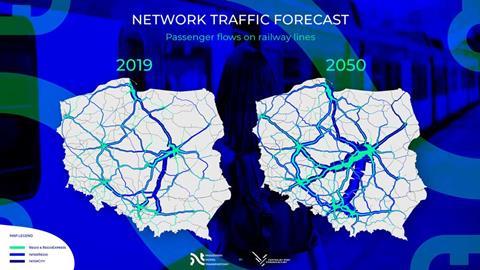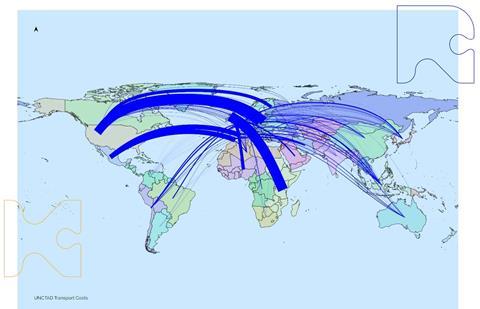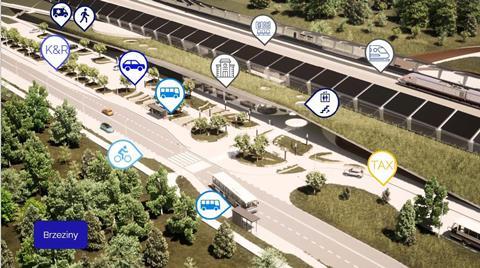The planned rail investments of Centralny Port Komunikacyjny are going to increase the number of long-distance rail passengers to 134 million by 2050, a factor of more than twice, according to the forecasts.
Integrated Clock-face Timetable for Poland, Passenger Transport Model, Freight Transport Model, Local Mobility Hubs – these are some of the company’s projects that allow for efficient investment planning. CPK presented them at the Trako railway fair in Gdańsk
By 2050, 134 million passengers will have used long-distance rail services, including: 108 million passengers for Intercity category trains and 26 million for regional express category trains. This is data from the Passenger Transport Model forecasts. The CPK programme includes almost 2,000 km of new railway lines, the construction of which should complement the railway network in Poland, fitting in with the investment plans of the Three Seas countries covering a total of 4,500 km.
“The planned rail investments should eventually see the construction of a High Speed Rail infrastructure in Central and Eastern Europe. Together with railway partners from the Three Seas region, such as Rail Baltica and Správá železnic, we want to ensure that transport that previously focused primarily on the east-west direction will be also developed in the north-south direction. As a result, we, as a region, are going to develop much faster economically”, says Radosław Kantak, CPK board member for rail investments.
“We are thinking not only about how to implement a particular investment from the designer’s point of view. We are also thinking about, through the eyes of the passenger, how passengers will be using this infrastructure in the future. We are looking at future timetables, journey times, frequencies, railway access and economic efficiency. This cannot be done on a piece of paper and irrespective of the thousands of variables. We have the concepts and tools at CPK to design the railway effectively and use its full potential”, says Michał Jasiak, deputy director of the Design Office at CPK’s Railway Division.
At the Trako fair in Gdańsk, representatives of CPK gave the first comprehensive presentation of the concepts and planning tools they use in the advanced railway planning and design process:
Integrated Clock-face Timetable for Poland (HRJ). A comprehensive timetable concept, which aims to create an offer that is comfortable for passengers and facilitates transfers between trains and other modes of transport. CPK’s experts came up with the assumption that, in order to increase the number of travellers, a modern timetable is needed that has been created directly for the needs of passengers. This is why the HRJ is cyclical – making it easy to remember (trains on a given route will depart ‘regularly’, i.e. exactly every half hour or every hour, for example). Another assumption is that the timetable must be legible, meaning it must be based on fixed train routes and ensure connections at specific junction stations. It is also crucial to set a minimum standard for the frequency of trains in such a way that passengers have to adjust to the timetable in the least possible way. HRJ is a concept being developed by CPK together with PKP PLK, CUPT and the Ministry of Infrastructure.

Passenger Transport Model (PMT). A tool for making passenger traffic forecasts, i.e. checking how many people are going to travel on a given route and by which means of transport in a given year. PMT is an advanced planning model that takes into account railway, road and air transport. It allows us, for example, to carry out comparative analyses of the competitiveness of rail and other modes of transport. An important feature is the ability to compile and compare public transport data, e.g. with forecasted road traffic volumes. By taking into account the impact of various factors (e.g. demographic forecasts, GDP factor, road expansion plans, changing long-distance and regional train volumes), CPK and other investors to whom the PMT is provided free of charge are able to predict how passenger numbers are going to develop on any line or at any railway station.

Freight Transport Model (TMT). A new model that has not been presented before. The first comprehensive tool in Poland for freight traffic analysis. It includes railway, road, air and maritime transport. It allows for the analyses of the relationship between these modes of transport in terms of competitiveness and freight handling. TMT analyses the movement of goods, not only within Poland, but on a European and global scale. The aim is to estimate possible shifts in cargo between different modes of transport. With TMT, the results on traffic volume, for example, are crucial for the correct dimensioning of the infrastructure. Adapting the infrastructure to meet modern freight transport requirements should create space for the actual transfer of freight flows from road to railway, including with the use of lightweight intermodal trains, which are going to be permitted on most CPK lines.

Local Mobility Hubs (LHM). The concept is to create complete interchanges where passengers, moving through a clearly designed space, have convenient access to the range of various modes of transport, e.g. trains, buses, bicycles and taxis. The company attaches great importance to the standard of railway stations and their functional connection to the surroundings. The aim is to encourage passengers to use the railway as one leg of their journey. By ensuring accessibility to long-distance and regional railways, CPK investments are going to benefit not only large cities, but also poviat (including former voivodeship) towns, such as Sieradz located at the junction of two HSR lines designed by CPK.

Intermodal transport planning. The concept is to create intermodal and semi-trailer terminals, allowing some freight to be transferred from road to rail. The CPK analyses confirm that on many sections of the planned HSR there is great potential for combining passenger traffic with rail freight in a model known as mixed. It is crucial to reserve space along the CPK railway lines, where it should possible to build intermodal terminals with high quality parameters, such as in terms of the length of the loading fronts (750 m) and efficient connection to the railway and road network. CPK experts assume that the terminals should be capable of handling intermodal units (containers and semi-trailers) in different handling systems: vertical and horizontal.
The Microsimulation-Analytical Model helps to design infrastructure suitable for the assumed train traffic. It is used to test various timetable scenarios, including those that take account the random situations, such as the closure of one of the tracks. In contrast, the economic efficiency of the transport system and infrastructure investment is tested by the Cost-Benefit Analysis Model.
All these tools and concepts used by CPK are the result of the work by in-house expert teams, which used the most up-to-date technological and business knowledge.
“For an infrastructure to meet the passengers’ expectations, whether in Poland or anywhere else, a number of analyses are needed prior to the construction process. When designing the infrastructure investment, we use macro-level modelling and examine the economic viability of the investment”, said Dan Moore, Director of Strategy and Analysis from the UK Department for Transport, who was present at the CPK presentation.
What are the benefits of the above tools? Passengers are going to receive a clear, convenient and cyclical timetable as well as a high quality station and interchange infrastructure. Cargo shippers are going to be the beneficiaries of the new intermodal infrastructure and stable capacity. Transport organisers at different levels should be able to synchronise their activities on a consistent network basis. This is going to help to avoid oversizing or underinvesting infrastructure and to set investment priorities based on specific data and figures.
CPK is preparing the construction of a total of approximately 2,000 km of HSR lines, of which feasibility studies (STEŚ) are either ready or under development for more than 1,500 km. Routes are selected and agreed on for more than 600 km. Of this group, an advanced design is already underway for more than 450 km, with the investment priority being the Warsaw - CPK - Łódź section, which is to be opened simultaneously with the first stage of the airport.

















